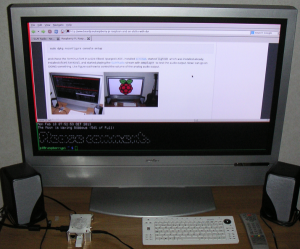I finally bought some Raspberry Pi stuff. I picked up the package yesterday after my night shift at and mounted one of them in the case I got for it and connected it to my ancient tv, with DVI as the most modern input choice. The first thing I tried was raspbmc. It boots, and […]
Cron, crontab example reference and how to run things periodically in GNU/Linux and Unix
Cron is a job scheduler found in most Unix-like operating systems. “Chronos”, which is the Greek word for “time”, is where the name cron comes from. Cron makes it possible to schedule jobs, which can be commands, a series of commands, or scripts, that you want to run periodically. Common uses are backups, notifications, periodic […]
Fixing missing menu entries of Opera and Skype in Debian GNU/Linux
Unfortunately the third-party packages of Opera and Skype do not contain menu entries for the Debian menu system. Not very surprisingly one might think, but I just think it’s sloppy. If you, like me, like the Debian menu system and want Opera and Skype available in it, do the following to solve that, until the […]
A revised opinion on apache2-mpm-prefork and apache2-mpm-worker, and php5 and php5-cgi on Debian, regarding performance
It’s now over a year since I wrote about “Exchanging apache2-mpm-prefork for apache2-mpm-worker, and using php5-cgi on Debian to improve performance“. Since then I have re-evaluated my opinion about running apache2-mpm-worker and php5-cgi on a low memory machine, specifically a virtual machine running under Xen, running Debian.
Jag och mitt skal – Verktygslådan, omdirigering av I/O
Förhoppningsvis är du bekant med grunderna rörande omdirigering av I/O (Input, Output) i skalet, i synnerhet grundkoncepten “standard input”, “standard output” och “standard error”. Om inte, så följer här en snabb genomgång, “standard input” är en datakälla, från vilken data kommer. Ett program varken behöver, eller ska bry sig om, varifrån data kommer, vare sig […]
Jag och mitt skal – Verktygslådan, introduktion och filosofi
Filosofin bakom verktygslådan var ett mycket viktigt koncept när Unix (av vilket GNU/Linux i stort sett är en klon) först designades och utvecklades. Olyckligtvis, i dagens värld av “webben” grafiska gränssnitt, “moln” och andra buzz-fjanterier, verkar denna filosofi till viss del glömts bort. Det är synd, eftersom denna filosofi ger oss den kraftfulla mentala modell, […]
Jag och mitt skal – Introduktion till terminaler och shells
Denna video är ju rolig på sitt vis, många tar den säkert dock på allvar, och tror verkligen att terminaler och skal i *nix (Unix, GNU/Linux, BSD, jag kommer i fortsättningen skriva *nix) är något svårt och komplicerat att använda sig utav. Men så är det inte, terminalen, och skalet, är det Sanna sättet att […]
How to set up a SIP trunk in the Asterisk PBX
In my previous article we configured Asterisk with some SIP-devices, and created a basic dialplan so that they could dial eachother. We also created two additional extensions for test purposes. This time I will show you how to configure a SIP trunk, and add extensions in the dialplan so that the telephones can dial out through […]
An introduction to Asterisk, The Open Source Telephony Project
Asterisk is software that turns an ordinary computer into a voice communications server. Asterisk is the world’s most powerful and popular telephony development tool-kit. It is used by small businesses, large businesses, call centers, carriers and governments worldwide. Asterisk is open source and is available free to all under the terms of the GPL. That […]
Installing Debian Lenny on an Asus EeePC 900, part two
I have had my EeePC for a while now, and I have set it up how I want it, for the most part. When I wrote the first part, about installing Debian on an Asus EeePC 900, I wasn’t very detailed about what I had, or were going to do, to make it run as […]
